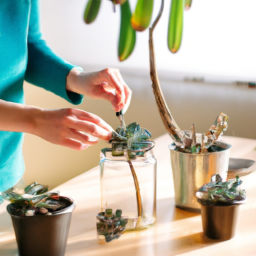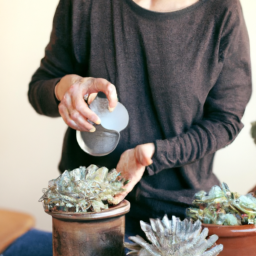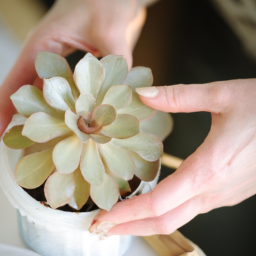
If you’re looking to add some greenery to your indoor space without the hassle of high-maintenance plants, succulents are the perfect choice. Care of succulent plants indoors is relatively easy once you understand their needs and preferences. These trendy plants come in a variety of shapes and sizes, making them a versatile and stylish addition to any room. In this blog post, we’ll explore the best practices for caring for succulents indoors, from choosing the right potting mix to providing proper lighting and watering. Whether you’re a seasoned plant parent or a beginner looking to green up your space, succulents are a great option for adding a touch of nature to your home.
Choosing the Right Succulent Varieties for Indoor Care
Understanding Your Indoor Environment
When it comes to choosing the right succulent varieties for indoor care, the first step is to understand your indoor environment. Succulents thrive in bright, indirect light, so it’s important to place them near a window where they can receive plenty of sunlight. If you don’t have a lot of natural light in your home, consider investing in a grow light to help your succulents thrive.
In addition to light, it’s also important to consider the temperature and humidity levels in your home. Most succulents prefer temperatures between 60-80 degrees Fahrenheit and low humidity levels. If your home tends to be on the cooler side, make sure to choose succulent varieties that are more cold-tolerant.
Choosing the Right Succulent Varieties
When it comes to choosing the right succulent varieties for indoor care, there are a few key factors to consider. Some succulents are more suited to indoor environments than others, so it’s important to choose varieties that will thrive in your home.
Some popular indoor succulent varieties include Echeveria, Haworthia, and Aloe. These varieties are known for their ability to thrive in indoor environments with proper care. When selecting succulents for indoor care, make sure to choose varieties that are well-suited to the light levels and temperature in your home.
In addition to considering the environmental factors in your home, it’s also important to choose succulent varieties that are easy to care for. Some succulents require more maintenance than others, so if you’re new to caring for succulents, consider starting with varieties that are low-maintenance and forgiving of beginner mistakes.
Caring for Your Indoor Succulents
Once you’ve chosen the right succulent varieties for indoor care, it’s important to provide them with the proper care to help them thrive. Here are some tips for caring for your indoor succulents:
1. Watering: Succulents should be watered sparingly, allowing the soil to dry out completely between waterings. Overwatering is one of the most common causes of succulent death, so make sure to water your succulents only when the soil is dry.
2. Light: Succulents thrive in bright, indirect light, so make sure to place them near a window where they can receive plenty of sunlight. If you don’t have a lot of natural light in your home, consider using a grow light to supplement.
3. Soil: Succulents require well-draining soil to prevent root rot. Use a cactus or succulent mix, or create your own by adding perlite or sand to regular potting soil.
By choosing the right succulent varieties for indoor care and providing them with the proper care, you can enjoy beautiful and thriving succulents in your home. Remember to monitor your succulents regularly and adjust your care routine as needed to help them thrive.

Proper Watering Techniques for Indoor Succulent Plants
Understanding the Watering Needs of Succulent Plants
Succulent plants are known for their ability to store water in their leaves, stems, and roots, making them well-suited for dry environments. However, this does not mean that they can go without water for long periods of time. In fact, overwatering is one of the most common causes of succulent plant death. To ensure the health and longevity of your indoor succulents, it is important to understand their watering needs.
One of the key factors to consider when watering succulent plants is the type of soil they are planted in. Succulents thrive in well-draining soil that allows excess water to flow out easily. This prevents water from pooling around the roots, which can lead to root rot. When choosing soil for your indoor succulents, opt for a mix specifically designed for cacti and succulents, or create your own by combining potting soil with perlite or sand.
Another important factor to consider is the season and temperature. Succulent plants go through periods of dormancy, during which they require less water. In the winter months, when growth slows down, succulents need less frequent watering. On the other hand, during the active growing season in spring and summer, succulents may require more water. Additionally, higher temperatures can cause water to evaporate more quickly, so you may need to water your succulents more often during hot weather.
It is also important to pay attention to the specific watering needs of different types of succulent plants. While most succulents prefer to dry out completely between waterings, some varieties, such as lithops and haworthias, prefer to be watered more frequently. Research the specific watering requirements of the succulents in your collection to ensure that you are providing them with the right amount of water.
How to Water Indoor Succulent Plants
When it comes to watering indoor succulent plants, the key is to water deeply but infrequently. Unlike other houseplants that may need to be watered more frequently, succulents prefer to be watered less often but more thoroughly. To water your indoor succulents effectively, follow these steps:
1. Check the soil moisture: Before watering your succulents, check the moisture level of the soil. Stick your finger into the soil up to the first knuckle. If the soil feels dry, it is time to water your succulents. If the soil still feels moist, wait a few more days before checking again.
2. Water thoroughly: When watering your succulents, water them thoroughly until water drains out of the bottom of the pot. This ensures that the roots receive enough water and prevents water from pooling at the bottom of the pot. Allow the excess water to drain completely before placing the pot back in its saucer.
3. Allow the soil to dry out: After watering, allow the soil to dry out completely before watering again. Succulents prefer to dry out between waterings to prevent root rot. Depending on the season and temperature, you may need to water your succulents every 1-2 weeks during the active growing season and less frequently during the winter months.
4. Adjust watering frequency: Pay attention to the signs that your succulents give you to determine if they need more or less water. If the leaves of your succulents start to look shriveled or wrinkled, it may be a sign that they need more water. On the other hand, if the leaves start to turn yellow or translucent, it may be a sign of overwatering.
By following these proper watering techniques for indoor succulent plants, you can help your succulents thrive and stay healthy for years to come. Remember to adjust your watering schedule based on the specific needs of your succulents and the conditions in your home. With the right care and attention, you can enjoy the beauty of indoor succulents in your living space.

Tips for Providing Adequate Light and Temperature for Indoor Succulents
Understanding the Light Needs of Succulents
Succulents are known for their ability to thrive in dry, arid conditions, which is why they are often associated with deserts. When it comes to caring for succulents indoors, providing adequate light is crucial for their growth and overall health. Succulents need plenty of bright, indirect light to thrive, so it’s important to place them near a window where they can receive at least 6-8 hours of sunlight per day.
If you notice that your succulents are starting to stretch or become leggy, it’s a sign that they are not getting enough light. In this case, you may need to move them to a sunnier spot or consider supplementing their light with a grow light. On the other hand, if you notice that your succulents are starting to develop brown spots or sunburn, it’s a sign that they are getting too much direct sunlight. In this case, you may need to move them to a spot where they can receive more filtered light.
It’s also important to rotate your succulents regularly to ensure that they are receiving even light exposure on all sides. This will help prevent them from becoming lopsided or leaning towards the light source. Overall, the key to providing adequate light for your indoor succulents is to observe them closely and make adjustments as needed to ensure they are getting the right amount of light.
Optimal Temperature Range for Indoor Succulents
In addition to light, temperature is another important factor to consider when caring for indoor succulents. Succulents are adapted to thrive in warm, dry climates, so it’s important to provide them with a temperature range that mimics their natural habitat. Most succulents prefer temperatures between 60-80°F (15-27°C) during the day and slightly cooler temperatures at night.
During the winter months, it’s important to protect your succulents from cold drafts and temperatures below 50°F (10°C), as they are not cold-hardy plants. If you live in a colder climate, you may need to bring your succulents indoors during the winter or provide them with supplemental heat to keep them warm. On the other hand, succulents can also be sensitive to extreme heat, so it’s important to protect them from temperatures above 90°F (32°C) during the summer months.
It’s also important to keep in mind that sudden temperature fluctuations can stress succulents and make them more susceptible to pests and diseases. To prevent this, try to maintain a consistent temperature and avoid placing your succulents near drafty windows or heating vents. By providing your indoor succulents with the right temperature range, you can help them thrive and stay healthy year-round.
Monitoring and Adjusting Light and Temperature Levels
To ensure that your indoor succulents are getting the right amount of light and staying within the optimal temperature range, it’s important to monitor these conditions regularly. Keep an eye on your succulents to see how they are responding to their current light and temperature levels. If you notice any signs of stress, such as wilting, discoloration, or legginess, it may be a sign that they are not getting enough light or are experiencing temperature extremes.
In addition to observing your succulents, you can also use a light meter to measure the amount of light they are receiving and a thermometer to monitor the temperature in their environment. This will help you make more informed decisions about where to place your succulents and how to adjust their light and temperature levels as needed.
Remember that each succulent species has its own specific light and temperature requirements, so it’s important to research the needs of your specific plants and adjust your care routine accordingly. By providing your indoor succulents with the right amount of light and maintaining a consistent temperature range, you can help them thrive and grow beautifully in your home.
Essential Points
Succulent plants are a popular choice for indoor plant lovers due to their unique shapes and low maintenance requirements. To ensure your succulents thrive indoors, it’s important to provide them with the right care. One key aspect of caring for succulents indoors is to ensure they receive adequate sunlight. Place your succulents near a sunny window where they can get at least six hours of sunlight per day. If natural light is limited, consider using a grow light to supplement their light requirements.
Another important aspect of caring for succulents indoors is to water them properly. Succulents are drought-tolerant plants, so it’s essential not to overwater them. Allow the soil to dry out completely between waterings, and water sparingly during the winter months when succulents are in their dormant phase. It’s also important to use well-draining soil and pots with drainage holes to prevent root rot. By following these tips, you can enjoy healthy and thriving succulent plants in your indoor space.
FAQ Compilation:
Q1: How often should I water my indoor succulent plants?
A1: Succulents do not require frequent watering. It is best to water them only when the soil is completely dry. This could range from once every 1-2 weeks, depending on the type of succulent and the environment it is in.
Q2: What type of light do indoor succulents need?
A2: Succulents thrive in bright, indirect sunlight. Place them near a window where they can receive plenty of natural light throughout the day. If your succulents start to stretch or lose their vibrant color, they may need more light.
Q3: How should I pot my indoor succulent plants?
A3: When potting succulents, make sure to use a well-draining soil mix specifically designed for succulents. Choose a pot with drainage holes to prevent water from pooling at the bottom. Repot your succulents every 1-2 years to refresh the soil and ensure proper growth.
Q4: Do indoor succulents need fertilizer?
A4: Succulents do not require frequent fertilization, but you can feed them with a diluted, balanced fertilizer during their active growing season (usually spring and summer). Be sure to follow the instructions on the fertilizer package to avoid overfeeding.
Q5: How can I prevent pests on my indoor succulent plants?
A5: To prevent pests like mealybugs and spider mites, regularly inspect your succulents for any signs of infestation. If you notice pests, isolate the affected plant and treat it with an insecticidal soap or neem oil spray. Keep your succulents clean and free from debris to discourage pests from taking hold.

James Wong is a renowned ethnobotanist, plant scientist, and local television presenter. With a passion for demystifying plant science, he is known for translating complex botanical concepts into practical advice for everyday plant enthusiasts. James’s expertise spans from traditional gardening to cutting-edge plant technologies, making his insights accessible and informative.


